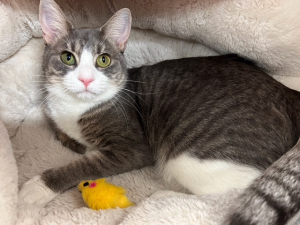
MUNDANE MYSTERIES: Why Olympic Winners Bite Their Medals
If you watched this year’s Olympics (or any Olympics, really), you may have noticed several winners full-ob old-timey prospector by chomping on their medal. Why do Olympians bite their medals? Do they believe the International Olympic Committee would actually try to pull a fast one? Or are they hoping it’s chocolate?
Biting on gold used to be a way for prospectors to tell if it was genuine gold, since slight bite marks would show up if it were the real thing. But most Olympians should know their “gold” medals are really made up mostly of silver & copper before being covered in gold. If each medal were actually solid gold, it would cost the IOC about $25K each! So why DO Olympians bite their medals?
Well, most likely they’re just following orders…photographer orders, that is. Olympic winners pose for their victory images in front of a throng of photographers, some of whom request that the athletes do something…anything…besides just standing there & smiling. Somewhere along the way over the years, winners picked up the habit of nibbling on their medal to satisfy the flashy feeding frenzy of the photographers.
But what happens if someone were to chip a tooth doing that? Well, it turns out…they have! German luger David Moeller actually broke off the corner of his tooth when he chomped on his silver medal back in 2010.
So, if you ever make it to the Summer or Winter Olympics & win a medal, it’d probably be safer to just thank them for your prize & either trust that it’s real, or wait & let a certified metallurgist examine your prize instead of moving on to medal munching.
Got a Mundane Mystery you’d like solved? Send me a message via Twitter (@AndyWebbRadio), or shoot me an email at [email protected].
Bronzie – the Jay Day and the Day Home Team Pet of the Week

Bronzie is a pitbull/terrier mix who is 3 – 4 years old.
She is 60 lbs and loves to play especially with balls.
Unfortunately, Bronzie’s previous family abandoned her and somebody else brought her into Frederick County Animal Control.
To see her and make her a part of your forever home call 301-600-1546.
MUNDANE MYSTERIES: What Is “Phishing”?
We’ve all known people or businesses that have fallen prey to “phishing” attacks. But what is a “phishing” scam? And why is it called that?
Back when the word originated, “phishing” attacks were specific to one single spot: AOL. In 1994, a group of enterprising hackers from across the country started impersonating AOL representatives in private chats, scamming unsuspecting AOL users into surrendering their login credentials & credit card info. The hackers were mainly just interested in stealing the data so they could use AOL through other people’s accounts, rather than having to pay for their own. One of the hackers nicknamed the process of baiting a person into turning over their personal details “fishing.”
By January 1995, the hackers had created “AOHell,” a software program that automated the process so that anyone (even non-hackers) could use boilerplate messages & options to “fish” for passwords or credit card numbers. It was in AOHell where “fish” was changed “phish”. Some people believe it was inspired by the phrase “phone phreak”, a term coined in the 70s for people who hacked phone lines to make free calls.
Phishing wasn’t AOHell’s only selling point. You could also, for example, “mail bomb” someone’s inbox with hundreds of spam emails; use the “Punt” button to log an AOL user out of their account; click “Ghost” to erase all comments except for yours; or send “a graphically obscene gesture” to everyone in a chat room.
But this group of hackers’ stint as the internet’s most powerful agenst of chaos didn’t last forever, nor did AOL’s reign as the online service provider of choice. But the concept of phishing continued to grow & mutate, as did the term “phishing”, which grew right along with it.
Got a Mundane Mystery you’d like solved, send me a message via Twitter (@AndyWebbRadio), or shoot me an email at [email protected].
Wake Up Crew Highlights: February 10, 2022
MUNDANE MYSTERIES: The Difference Between Frosting & Icing
A cake with frosting. A doughnut with icing. What’s the difference between frosting & icing? The dictionary defines icing as “a sweet flavored usually creamy mixture used to coat baked goods … called also ‘frosting’.” And the definition for frosting? “Icing.” So, is there a difference?
From a culinary standpoint, frosting & icing are not the same. Frosting is generally fluffier & thicker, thanks to its most important ingredient…fat. That fat can be different things: butter, cream, cream cheese. And being thicker, frosting usually stays in whatever shape it’s spread, making it ideal for cakes, cupcakes, and between cake layers.
Icing, on the other hand, is less fluffy, runnier, and sometimes translucent (especially before it dries). While frosting is defined by its inclusion of fat, icing has a bigger focus on sugar, usually of the powdered variety, combined with water & other ingredients. It’s great for decorating cookies, since you can pipe out a thin layer that’ll harden as it dries. But not all icing is runny. Rolled fondant, which you can commonly find on wedding cakes & other specialty pastries, is a thick fusion of sugar, water, and corn syrup that you can roll & cut like you would dough. But, because of its sugar & water base, it’s still considered icing.
But then, there’s “glaze”, which is also a combination of sugar & liquid, making it more closely related to icing than frosting. It’s the thinnest of the three—so runny that it’s poured over a dessert, rather than piped or spread. While glazes may get stiffer when dry, they don’t typically harden like an icing would. They’re great for drizzling over things like pound cakes and doughnuts.
Whichever one you prefer to have, the choice is clear: eating something with either frosting, icing, or glaze on it is better than eating something without it.
Got a Mundane Mystery you’d like solved, send me a message via Twitter (@AndyWebbRadio), or shoot me an email at [email protected].
Tiger the Jay Day and the Day Home Team of Real Estate Teams Pet of the Week
Wake Up Crew Highlights: February 7, 2022
MUNDANE MYSTERIES: How Long Are N95 Masks Good For?
We’re all trying our best to keep ourselves safe as the pandemic wears on. And one of the most frequently asked questions amidst our precautionary efforts is, “How long can I wear my N95 mask before I need to throw it out?” N95 masks, which are the most effective masks available, don’t have a rigid expiration date. So, we have to use our best judgment based on our individual situations, as well as each mask’s individual condition. But there are some guidelines we can all follow.
If there is any sign that your mask is dirty or defective, then toss it out. Did it get wet? Throw it away. Is it stained? Chuck it. Maybe the straps are stretched out & it feels loose on your face? Get rid of it.
If your mask still looks & feels to be in good working order, however, you could potentially use it a while longer. According to recommendations from the CDC, it’s a good idea to keep multiple N95s in a rotation & wear a different one each day. Then, to provide your mask an opportunity for any virus particles it may have picked up to die out between uses, store each individual mask in separate paper bags or other “breathable” container to ward off contamination (of the mask, itself, or of someone or something else).
How long should you keep a mask in rotation before chucking it in the trash? Well, the CDC & a number of other experts recommend a maximum of five wears per N95 mask. But, again, if any of your masks looks to be warped or soiled or faulty in any way, even if after only a single use, you’re better off not trying to stretch its life out any longer. Toss it & get another new one.
Safety’s the name of the game, and you want to be as protected as possible. Wearing a good N95 mask is still one of the most effective ways to keep yourself & others safe until the pandemic ends (which, hopefully, will be sooner rather than later).
Got a Mundane Mystery you’d like solved? Send a message via Twitter (@AndyWebbRadio), or email [email protected].
